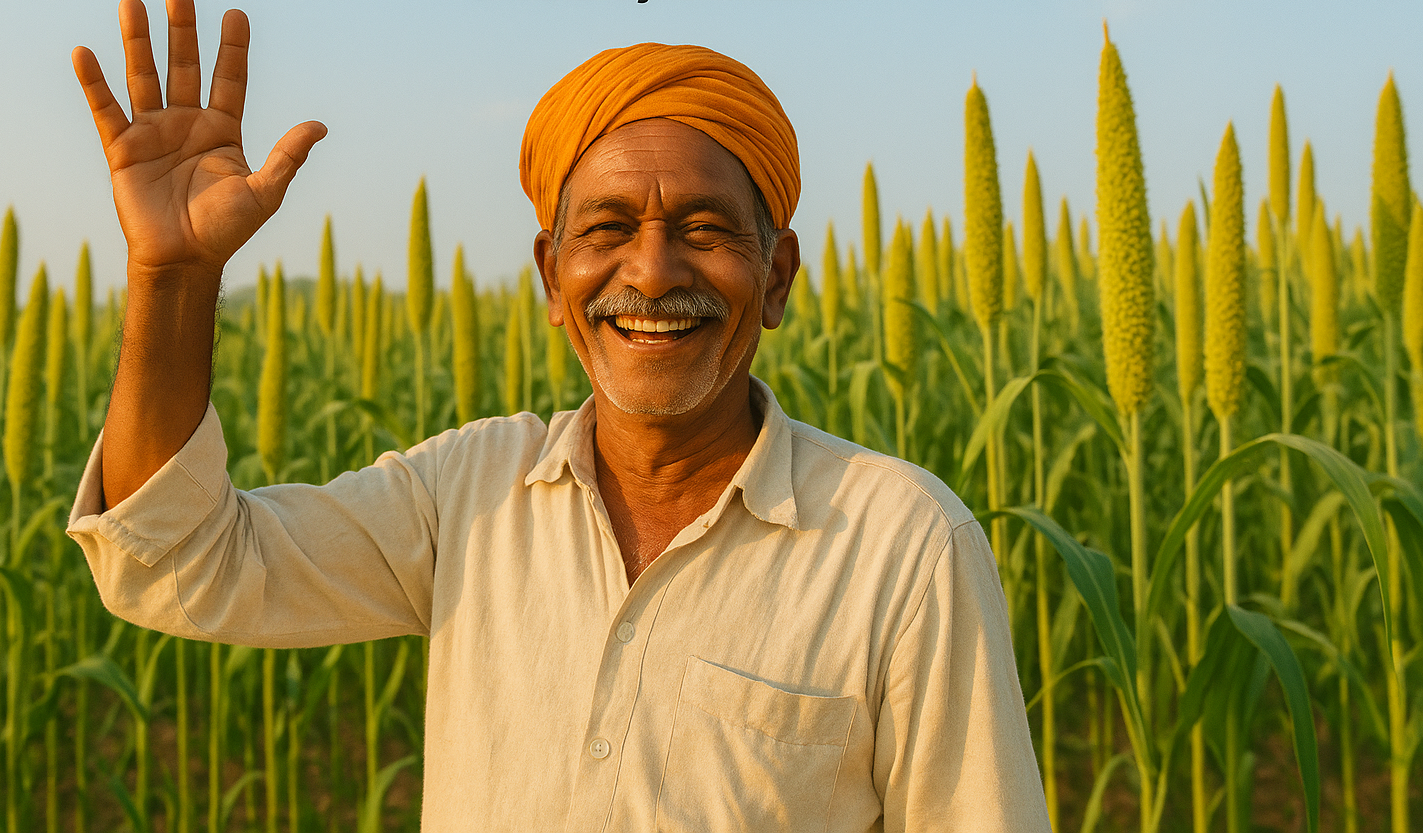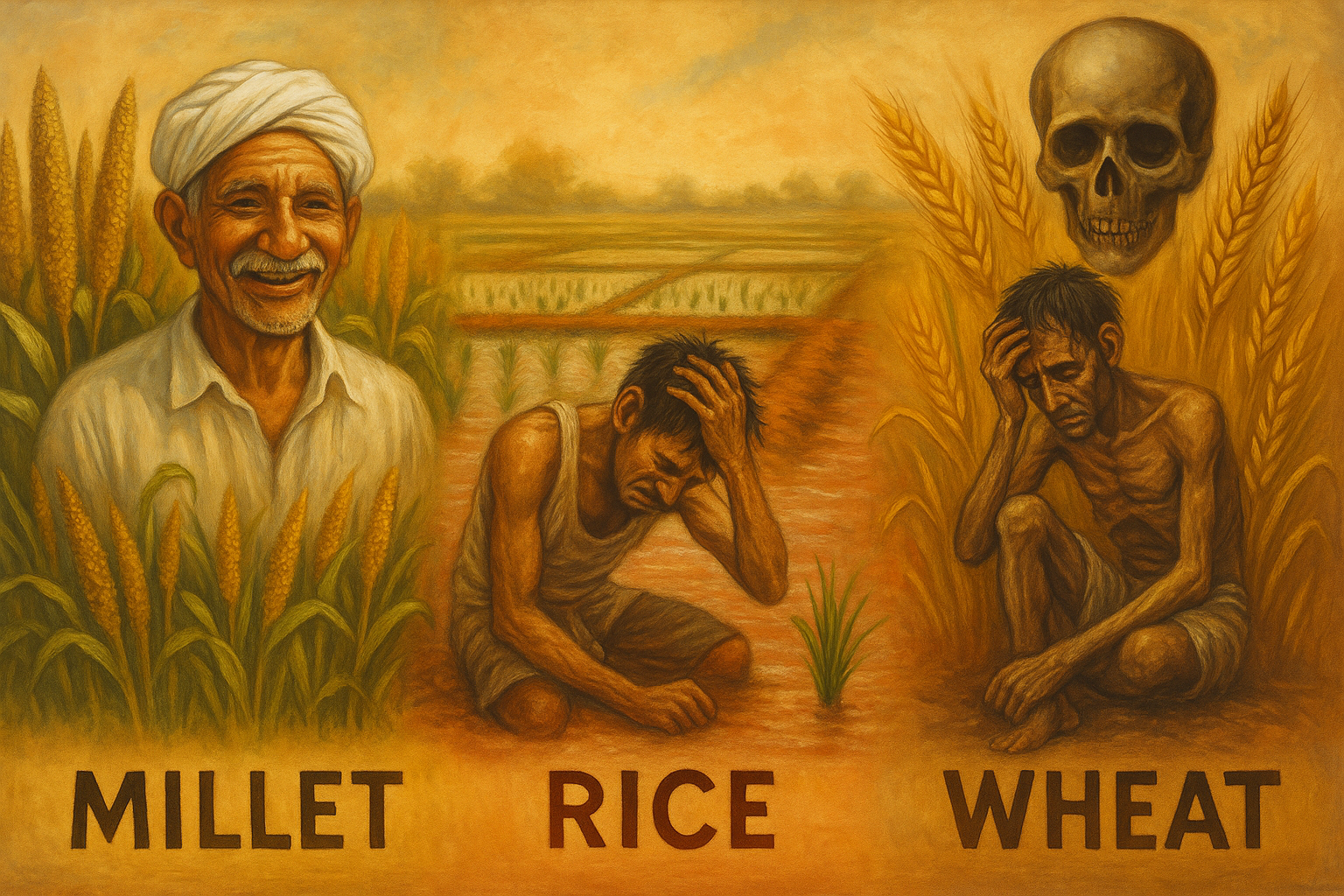In the heart of our fields, under the same sun and sky, grow three humble grains—millet, rice, and wheat. They may look small in our hands, but each carries the weight of history, culture, and survival. Behind every grain is a story—of sweat-drenched farmers, aching backs, patient waiting, and hope. But which one truly nurtures the land, the farmer, and us?
Let’s walk through their journey—from soil to stomach.
Table of Contents
Millet vs Rice vs Wheat:
Every grain in our home has been touched by the hands of a farmer who gambled with weather, pests, and the market.
🌾1. Cultivation & Crop Requirements
| Factor | Millet | Rice | Wheat |
|---|---|---|---|
| Water Needs | Very low; drought-resistant | Extremely high (especially paddy) | Moderate |
| Soil Requirements | Grows in poor/fertile soil | Needs fertile, well-irrigated soil | Needs good soil but less water than rice |
| Climate Suitability | Grows in arid/semi-arid regions | Requires monsoon or irrigation | Cooler climates; rabi crop |
| Growing Cycle | Short (2–4 months) | Long (4–6 months) | Medium (4–5 months) |
💸 2. Farmer Debt & Economic Impact
| Factor | Millet | Rice | Wheat |
|---|---|---|---|
| Input Costs | Low (minimal fertilizer/pesticide) | High (fertilizers, water, electricity) | Moderate to high |
| Market Support | Weak (less MSP & procurement) | Strong MSP & government procurement | Strong MSP & procurement |
| Debt Risk | Lower due to low input cost | Higher due to input cost + loan cycles | Moderate |
| Suicide Link | Rare (less economic pressure) | High correlation in some regions | Moderate correlation |
🌍 3. Planetary & Environmental Impact
| Factor | Millet | Rice | Wheat |
|---|---|---|---|
| Water Use | Minimal | Very high (major cause of groundwater depletion) | Moderate |
| Methane Emission | Very low | High (from flooded paddy fields) | Low |
| Fertilizer Demand | Very low | High | High |
| Sustainability | Highly sustainable & climate-resilient | Unsustainable in many areas | Moderately sustainable |
👑 4. A Glimpse into History
Millet: The Ancient Grain We Forgot
Millet is one of the oldest grains known to humanity. It was grown and eaten in India, Africa, and China over 8,000 years ago. In fact, millet was the first cultivated grain in India, long before rice and wheat arrived. It fed our ancestors during droughts and hard times, especially in dry and rocky regions where nothing else would grow.
Millets were part of everyday life — simple, wholesome, and strong. But as modern agriculture grew and polished grains became popular, millet slowly disappeared from our plates and fields. Today, it’s making a quiet comeback — not just as a food, but as a symbol of sustainability and resilience.
Rice: The Grain of Ritual and Rain
Rice has a deep and emotional place in Indian culture. It became widely cultivated around 5,000–6,000 years ago, especially in regions with heavy monsoons and fertile plains like Bengal, Odisha, and Tamil Nadu.
Over time, rice became a symbol of prosperity, purity, and celebration — present in festivals, weddings, and prayers. But rice needs a lot of water to grow. In areas where irrigation is forced to support it, it has contributed to groundwater depletion and high farmer debt, especially with high-yield hybrid varieties introduced during the Green Revolution.
Despite its beauty and cultural value, rice has become a burden in regions where it was never meant to grow.
Wheat: The Grain of Power and Progress
Wheat came to India from West Asia and Europe, and became common during the Indus Valley civilization. But its real rise in India happened after independence, especially during the Green Revolution in the 1960s and 70s.
Wheat was promoted heavily with subsidies, irrigation, and fertilizers to ensure food security. It became a major Rabi (winter) crop, especially in Punjab, Haryana, and Uttar Pradesh.
It brought short-term success but long-term strain — on soil health, biodiversity, and farmers’ mental health. Chemical dependence and single-crop farming left many farmers stuck in cycles of loans and losses.
✅ Summary: Why Millets Matter
- For Farmers: Millets offer a low-risk, low-investment option, especially for smallholders in dry zones. They’re less likely to push farmers into debt.
- For the Planet: Millets are eco-friendly, water-efficient, and climate-resilient, making them ideal for a sustainable future.
- For the Economy: While market support is currently weak, increasing millet consumption can revive traditional crops and diversify rural incomes.
- For Society: Reduced input costs and climate adaptability make millets a tool for reducing farmer distress and suicides.
🧠 5. Nutrition:
Millet vs Rice vs Wheat
| Nutrient/Aspect | Millet | Rice (White) | Wheat (Whole) |
|---|---|---|---|
| Protein | Moderate (9–11g/100g) | Low (6–7g/100g) | High (12–14g/100g) |
| Fiber | High | Very Low | Moderate |
| Iron | High | Low | Moderate |
| Glycemic Index | Low | High | Medium |
| Gluten | Gluten-free | Gluten-free | Contains Gluten |
| Micronutrients | Rich in magnesium, zinc, B-vitamins | Poor | Moderate |
🏋 6. Health Benefits:
Millet vs Rice vs Wheat
| Health Aspect | Millet | White Rice | Whole Wheat |
|---|---|---|---|
| Gluten-free | ✅ Yes | ✅ Yes | ❌ No |
| Supports digestion | ✅ High fiber | ❌ Very low fiber | ✅ High in fiber |
| Blood sugar control | ✅ Low GI, slow carb absorption | ❌ High GI; quick sugar spikes | ⚠️ Moderate GI |
| Weight management | ✅ Keeps you full longer | ❌ Less filling | ✅ Good satiety |
| Heart health | ✅ Rich in antioxidants & magnesium | ❌ Poor in heart-protective nutrients | ✅ Supports heart health |
| Bone strength | ✅ Good calcium & magnesium | ❌ Low in bone-support nutrients | ✅ Moderate calcium & magnesium |
| Rich in B Vitamins | ✅ Supports energy, nerves, and brain health | ❌ Very low in B vitamins | ✅ Especially rich in niacin & thiamine |
| Antioxidant content | ✅ High | ❌ Very low | ⚠️ Moderate |
| Iron content | ✅ High | ❌ Low | ✅ Good amount |
🧠 Why B Vitamins Matter
- Thiamine (B1): Supports nerve function, energy metabolism, and muscle health.
- Riboflavin (B2): Important for skin, eyes, and converting food into energy.
- Niacin (B3): Helps lower cholesterol, supports brain health, and aids in DNA repair.
Summary:
- Millets help control diabetes, improve digestion, and are great for heart health. They’re naturally gluten-free.
- Rice (especially white rice) gives quick energy but causes blood sugar spikes. Low in nutrients unless fortified.
- Wheat is nutritious but contains gluten, which can be problematic for some. Good source of energy and protein.
Videos
Watch the video in Hindi –
See more millet videos on Good Health YouTube channel.
❤️ The Emotional Verdict: What Should We Choose?
Millets are more than a food trend—they’re a revolution waiting to happen. A return to our roots.
By choosing millets, we don’t just nourish ourselves—we ease the burden on farmers, preserve water, and heal the planet.
Rice and wheat have served us well, but the future needs a resilient grain.
The future needs millets.
Call to Action:
🙌 💫 Eat with heart. Choose with wisdom.
Let’s Bring Millet Back to Our Plates
Let’s revive the grains our grandmothers once loved. Let’s listen to the soil, the rain, and the farmer’s silent plea.
Because the food we choose is not just about taste.
It’s about empathy, awareness, and hope.
A Gentle Goodbye, and a Door to More 🌾
As we close this chapter on millet, rice, and wheat — the grains that shaped our land, our meals, and our farmers’ fates — may something within you stir. A new awareness, a deeper care.
Our soil speaks. Our farmers struggle. But in mindful choices, hope begins.
If this story moved you, know that there’s more waiting for you. More grains, more recipes, more heart-touching truths — all woven through the pages of this blog.
Take your time, wander through. Each post is a small step toward a more conscious plate and a more compassionate world.
👉 Browse more stories, recipes, and reflections — your journey with food has only just begun.


1 thought on “Millet vs Rice vs Wheat – 3 Grains 3 Tales – Choose With Wisdom, Eat with Heart”